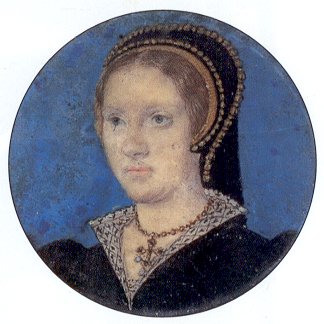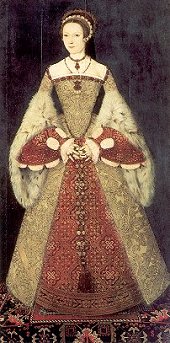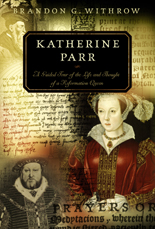In my previous story about Katherine Parr, I gave a very brief overview of her life. I emphasized the courage that she had as the sixth and last wife of Henry VIII. It was not easy to be married to the most powerful man in the kingdom, especially when he had set aside two wives, executed two other wives, and callously remarried within only a few months after the death of the one whom he referred to as his most beloved.
life. I emphasized the courage that she had as the sixth and last wife of Henry VIII. It was not easy to be married to the most powerful man in the kingdom, especially when he had set aside two wives, executed two other wives, and callously remarried within only a few months after the death of the one whom he referred to as his most beloved.
It is easy to see why Henry VIII would marry Katherine though. She was a virtuous and wise woman. Henry knew her family for many years. They were also fourth cousins. The Parr family had been in the inner circle of the court during Henry VIII’s reign. Katherine’s father, Thomas, was eventually knighted. Henry watched Katherine grow up into a beautiful, intelligent, kind, caring, and giving woman.
Katherine had married twice and was widowed twice. She was engaged to Thomas Seymour, whom she loved deeply, when Henry set his cap for her. Of course, Henry was the king and bound to get his way. He sent Thomas Seymour to Brussels as the ambassador to the Netherlands. This cleared the way for him to marry Katherine. By this time, Henry had his son and heir, and was ready to settle down; he chose this outstanding woman to be his wife.
One of the things about Katherine that interested Henry was her classical education. He was ready for a companion to spend long hours conversing with. He was also able to trust her with the regency of the country when he went to France in 1544 to fight a war. He needed someone who could speak many languages, including Latin which was the favorite form of correspondence in their day. She would not need to worry about those around her trying to take advantage of the king’s absence and putting their own agendas into place. She needed no one to translate for her. She met Henry’s expectations and did a successful job of guiding the country in his absence.
Though Katherine used Latin, she was more interested in bringing the common tongue of the people into use. She encouraged the translation of the Bible, as well as church liturgies, songs, and prayers into English. She sponsored translation projects, including a treatise by Marguerite of Navarre, another erudite Christian woman of this era. You can read about her elsewhere on this Blog.
Katherine published her own works, except for one poem, in English. In this way, Katherine was a cultural reformer. We know that she was a religious woman, but we do not know for sure that she favored any particular belief system at this time.
 We do know that Katherine was on a spiritual journey in her faith. While Henry was away campaigning in France, he left Thomas Cranmer as one of Katherine’s advisors. Possibly under his influence, Katherine became more interested in the Reformed faith. When Henry came back from France, she began pressuring him for reforms in the church.
We do know that Katherine was on a spiritual journey in her faith. While Henry was away campaigning in France, he left Thomas Cranmer as one of Katherine’s advisors. Possibly under his influence, Katherine became more interested in the Reformed faith. When Henry came back from France, she began pressuring him for reforms in the church.
Around this time Katherine published her, Prayers or Meditations, a devotional work. It is a general Christian work, not particularly Catholic or Protestant. It contains her personal serious introspections. It was not meant to be related to any liturgical observances, but is purely devotional in nature. It was not until after she published this work that she turned completely to the Reformed point of view.
It was about one year later, 1546, that an ardent Reformer named Anne Askew was put on the rack and tortured for her faith. You can read Anne Askew’s story in another posting on this Blog. Recall that the Catholic faction headed up by bishops Gardiner and Wriothesley were trying to find a way to turn Henry against Katherine for their own selfish ambitions. They sought to find a tie between Anne and Katherine. Anne refused to talk and was tortured and then burned at the stake.
Gardiner and Wriothesley poisoned the king’s mind by telling him that the queen sought to be Henry’s teacher in spiritual things. Henry would not tolerate anyone, especially a woman, to be his teacher. At this point, Katherine became more careful about asking Henry for reforms. She barely escaped the plot against her life by Gardiner and Wriothesley by going to Henry and humbling herself and reconciling with him. She apologized to Henry, professing her inferiority, and assured him that she only meant to have meaningful conversation with him so he could forget the pain in his leg and also so that she could benefit from his spiritual wisdom. Though she was trying to preserve her life, she truly did believe that the husband is the spiritual head of the house.
Henry was satisfied with Katherine’s response and completely befriended her again. By this time Katherine had written, The Lamentations or Complaint of a Sinner, but she wisely put off getting it published until after Henry’s death. She feared another plot by Gardiner. She needed to only wait a few months, as Henry died in early 1547.
After Henry’s death Katherine married the man she loved, Thomas Seymour. Thomas was unfortunately not a faithful man. Katherine’s marriage was not as happy as she had hoped for. She loved him and supported him anyway. He and Katherine had one daughter, Mary. Katherine was 36 years old by this time. This was her first child and her pregnancy was hard. A few days later she contracted a high fever and died, September 5, 1548.
Katherine reveals much about herself in her writings. It is worth getting a copy of her publications and reading them. One excellent book, which contains a short biography of her and the texts of Prayers or Meditations, The Lamentation or Complaint of a Sinner, and various letters, is by Brandon G. Withrow, entitled, Katherine Parr: A Guided Tour of the Life and Thought of a Reformation Queen.
short biography of her and the texts of Prayers or Meditations, The Lamentation or Complaint of a Sinner, and various letters, is by Brandon G. Withrow, entitled, Katherine Parr: A Guided Tour of the Life and Thought of a Reformation Queen.
Here I will quote just a few excerpts from her writings to give you a flavor of this godly woman who searched for and found faith in God and salvation in Jesus Christ.
– – – – – From Prayers or Meditations:
“Most benign Lord Jesus, grant me thy grace, that it may always work in me, and persevere with me unto the end.”
“Let there be always in me one will and one desire with thee; and that I have no desire to will or not to will, but as thou wilt.”
“Grant me above all things that I may rest in thee and fully quiet and pacify my heart in thee.”
“O what thanks ought I to give unto thee, who hast suffered the grievous death of the cross, to deliver me from my sins, and to obtain everlasting life for me?”
“O Lord Jesus, thou art all my riches, and all that I have, I have it of thee.”
“To thee, O Lord, be honour, glory, and praise, for ever and ever. Amen.”
“Laudes in deum in aeternum (Praises to the eternal God.) Amen.”
There is much more. In these prayers we read that Katherine sees the Christian life as centered on the heart. She is searching for spiritual experience and rejoicing at the same time. She asks her readers to forsake their sins, and find forgiveness in Christ. Prayers or Meditations was very popular with the Christians in England and it went through seventeen editions by 1640.
– – – – – Opening paragraph from The Lamentation or Complaint of a Sinner:
“When I consider, in the bethinking of mine evil and wretched former life, mine obstinate, stony, and untractable heart to have so much exceeded in evilness, that it hath not only neglected, yea contemned, and despised God’s holy precepts and commandments: but also embraced, received, and esteemed vain, foolish, and feigned trifles: I am partly by the hate I owe to sin, who hath reigned in me, partly by the love I owe to all Christians, whom I am content to edify, even with the example of mine own shame, forced and constrained with my heart and words, to confess and declare to the world, how ingrate, negligent, unkind, and stubborn, I have been to God my creator: and how beneficial, merciful, and gentle, he hath been always to me his creature, being such a miserable and wretched sinner. “ Katherine goes on to ask her readers to forsake their former sins as she has and trust only in the mercy and grace of the cross of Jesus Christ.
Katherine’s life stands as a shining example to us of what it means to stand for Christ even during difficult times. It took a lot of courage for her to follow her heart during a time when it was difficult for women to have any influence. Others who believed in her persuaded her to publish her works, and she bravely and humbly overcame obstacles in order to show others by her example what the life of a committed Christian should be. She was willing to bare her personal failures if others would also turn and find grace at the cross of Christ. Many people through the centuries have been blessed by her efforts. It would be well if women and men today would discover this remarkable Queen of England.

